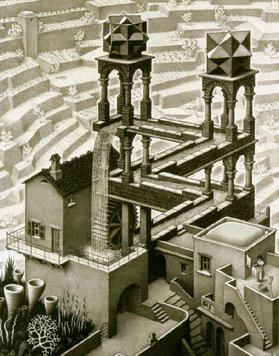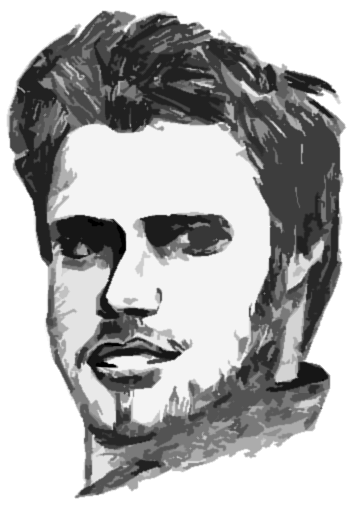Stylistic Aspirations: M.C. Escher
One cannot love geometry and art without loving MCE, Perhaps it is simply impossible for one to not love Escher.
Whilst I could postulate that the intrinsic mathematical principles in his works resonate with all of us on a universal level, he has this to say on reality:
As far as I know, there is no proof whatever of the existence of an objective reality apart from our senses, and I do not see why we should accept the outside world as such solely by virtue of our senses.
Which is the kind of sentiment that is adopted by players of 'Deal or No Deal' when they spend $43,000 for a 1/5 to actually do better than it.
That said Escher often covered theme's like recursion as below:

And other perpetual energy machines that are also under laws of physics impossible:

But rather than explore mathematical principles and impossibilities through architecture, tessellation and metamorphoses, I have to say I am a big fan of his line work and composition.
Much like Alan Moore, Escher is a man who takes the full potential of his medium, being the 2d image and with a little thought exploits it.
What I like most in his architectural work and optical illusions is his use of vanishing points and creating 3d perspectives. Which in turn allow him to build structures that could never be built in a 3d medium. Or at least if they were to be built in a 3d medium would only be viewable from one given perspective (the perspective that escher gives the image).
I have seen a model constructed of Escher's 'ascending and descending' and whilst from the correct perspective looked as though someone had built his impossible staircase, from others it looked like the sydney opera house as the dimensions of each step were required to become ever more distorted.
What really though allows Escher's 2d images to trump the 3d medium is that he can place people on his structures that are not distorted such that your minds eye must construct the building as impossibly as it appears, to have staircase that climb onto their lowest step and waterfalls that feed themselves.
For me that's the ultimate in any medium, to find a message that could not be communicated in another medium.
I also though really like Escher's early wood cut prints, particularly the landscape reflected in puddles ones. Escher I have a particular soft spot for because he did the majority of work in black and white. Much like my studio art folio in year 11, where my visual diaries contained black and white sketch after sketch after sketch until I settled on my triptych design, whence then it was pointed out to me that I intended to paint them in colour and hadn't done any exploration of colour.
To me colour is a given, if I'm going to do them at all. I only really struggle with the flesh tones, and otherwise, it is much much easier to translate colour from mind to page than it is to translate form from mind to page.
And again Escher uses straight lines to great effect, particularly in the woodblock prints. Alas I work with pens and pencils, and have only dabbled with lino=print. Wood block for reasons I don't understand in both eschers work and the Traditional Japanese prints seem to give the most defined lines in visual art. Perhaps because there is only one roll of the brush to the entire piece.
Alas, avast and so on, perhaps Escher is also the hardest to stylistically emulate. He is down officially as a Graphic Designer, suggesting that technique is the word to use more than style, and whilst I love the straight line, I hate using rulers. I work in jagged compositions not measured compositions.
Techniques such as vanishing points and perspective I feel is a matter of practice, that whence 10,000 hours or whatever Malcolm Gladwell thinks the magic number is I would be an accomplished imitator not someone who had developed their own style. I could then go on to illustrate development proposals for strip malls in what used to be neighbourhoods with character and culture like my beloved Brunswick.
Oh well, if I had the mind to concieve of tessalations and perpetual motion machines I would have done so by now.

No comments:
Post a Comment